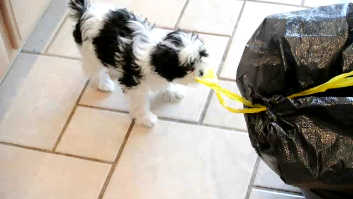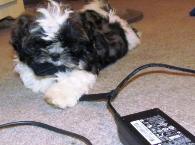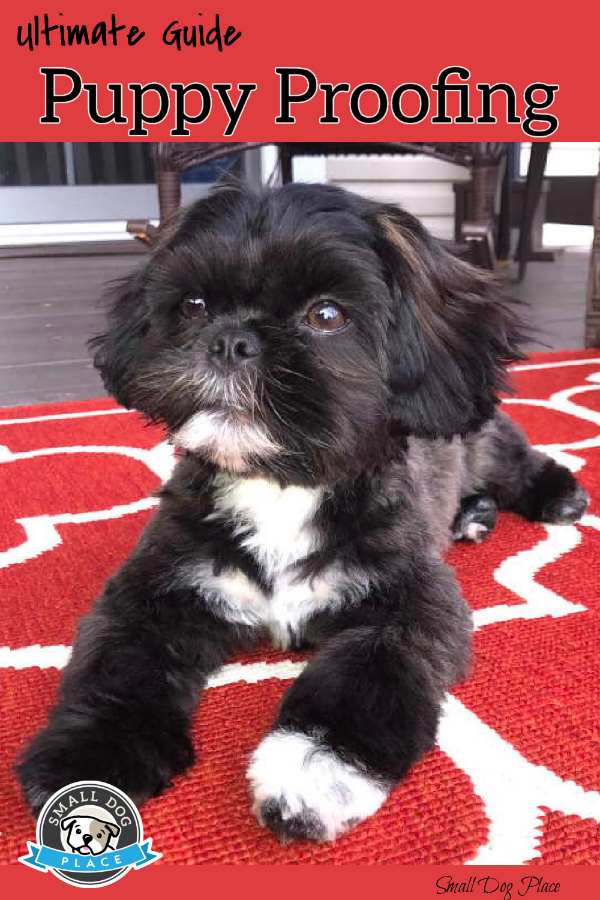- Small Dog Place Home
- About Puppies
- Puppy Proof Your Home
Puppy Proof Your Home for
Your Small Breed Dog
Puppy Proof Your Home By Janice A Jones | Last Updated 07-21-2022
When is it important to puppy proof your home? The answer is easy: Long before your puppy comes home for the first time.
A small breed puppy is not like a large breed puppy that can do substantial damage in a short period of time. They are also not like a human toddler or preschooler who have their own ways to stir up trouble.
But as a pet parent you will want to keep them safe and out of harm’s way while protecting your possessions from the puppy. That is why you will want to puppy proof your home.
By now, you're probably asking yourself, what's the big deal? How much trouble could a small puppy get into anyway? After all, they can’t knock over a lamp with the swish of a tail or reach the counter and eat your birthday cake.
The answer is that they can do a tremendous and often costly damage in a short period of time, even when you are in the same room.
I know because I learned the hard way. Eyeglasses, laptop power cords, small trash cans knocked over, woodwork chewed, well... those are only a few of the more expensive items I've had to repair or replace. Other annoyances such as chewed pencils, unwound balls of yarn, rolls of toilet paper spread over the entire house...
So, I can hear you saying, one of two things:
My puppy would never do those things, or
Maybe I really don't want a puppy after all.
Puppies as well as older dogs are opportunists. They see something they want and if there is not a person to tell them otherwise, they will seize the moment.
(Oh, you really do want a puppy.)
The good news is that much of this can be eliminated by a few simple changes to your environment.
Puppy proofing is neither difficult or time consuming. It just requires a little thought.
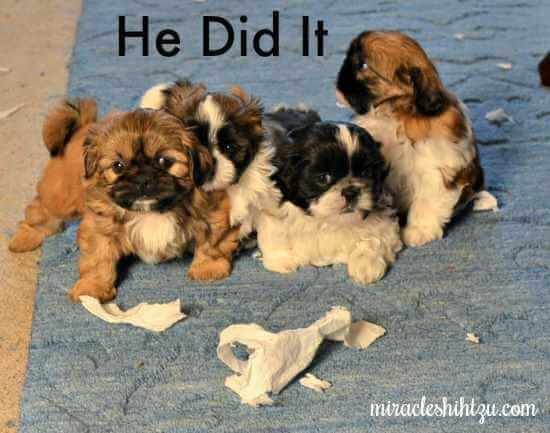 Puppies Like to Tear Up Paper
Puppies Like to Tear Up PaperPuppy Proofing as a Way to Protect Your Puppy
It's natural to want to preserve your home from damage that can result from puppy chewing, but puppy proofing can also help keep your new baby safe. Think about all the dangers that a small dog can encounter.
Household Poisons
Most cleaning products we use are poisonous and even ingesting a small quantity can be extremely dangerous, so you don't want to keep anything accessibly that your puppy could eat.
Household Plants
Puppies are curious and will try to nibble any greenery that they can reach. Some plants are harmless but there are many that are toxic and can cause illness or even organ damage. Check your household plants to be sure they are not harmful to dogs. Find new places to display all of your lovely plants. This goes for outdoor plants as well.
Cords
It's almost impossible to eliminate all the electrical cords in our environment, but it's important to find a way to keep them out of reach of your puppy. Not only is it costly to replace cords but it can also be dangerous for your puppy to chew through a live wire.
Radon
Another health concern for your dog is radon poisoning. Radon poisoning happens when your dog has an elevated radon level in the body.
As radon is a radioactive gas, overexposure can lead to serious health issues, potentially causing cancer. Dogs are even more likely to get radon poisoning faster as our furry pets spend most of their time indoors. Besides, their smaller lungs make them more vulnerable to radon poisoning.
The symptoms of radon poisoning found in dogs are mostly coughing, fever, breathing troubles, and a loss of appetite. Unfortunately, neither pets nor humans can smell or see radon poisoning, and the best way to stay safe from this toxin is by testing for radon, installing proper ventilation, or even considering a radon mitigation system.
Your Plan of Action to Puppy Proof Your Home
To Puppy proof your home you must get down to the level of a small puppy and think about all the neat things they might want to explore, chew, eat, shred or otherwise destroy.
Anything that is on the floor in the room or area you have set aside for your puppy is fair game including the floor itself.
Unless you watch every move your puppy makes, he can get into trouble very quickly. A curious puppy can either get hurt or destroy anything in his path. Neither of these are likely to have a happy outcome.
Puppy Proof Your Home By Starting With a Puppy Enclosure
Some small breed puppies can be so calm and dependent that you are lured into a false sense of security. But don’t let them fool you—they are a very curious and curious little dogs can get into big trouble real fast.
It is much easier if you plan to keep your new puppy in an exercise pen which is tastefully decorated with two dog bowls, a crate and/or bed, some toys and some wee-wee pads.
In the sanctuary of an x-pen, your puppy and your belongings are safe.
What if you don’t have an x-pen?
I can remember the very first puppy we ever had in a small apartment where there was no room for an x-pen.
The logical place for the puppy while we were at work was the bathroom. It was tiled, no rugs and a convenient place to put down food and water bowls, a bed and the various sundry toys that we had purchased, plus plenty of pee pads.
Were we ever surprised when we came home from work to find the puppy comfortably resting on three rolls of shredded toilet paper which flooded the entire bathroom about 4 inches deep! On to plan B, we decided.
When You Puppy Proof Your Home, Make a Special Place for Puppy
- An exercise pen or x-pen as they are often called can provide an excellent puppy to sleep, eat and play. Most puppies will grow accustomed to his area but some are quite vocal in their protest of being confined.
- Another option is a puppy play pen. A smaller container than an x-pen, but still spacious enough to add a couple of bowls, a bed and a few toys.
Here are a couple of examples of exercise pens and play pens to help you puppy proof your home.
- A third option is a crate that is big enough for the puppy to lie down, stretch out, stand up and turn around. There isn't much room for bowls and pee pads, but those extra items defeats the purpose of crate training. It is cruel and unhealthy to keep a tiny puppy in a crate all day while you're at work. Unless you can arrange for someone to come in to let the puppy out to relieve himself during the day, the crate method of potty training will not be effective.
- Another idea is to choose a small room such as a bathroom, kitchen, laundry room or other room that is not carpeted. The room can be partitioned off by the use of infant gates. A four by five foot area is all that a small puppy really needs. His area should be big enough for a bed or crate, a food bowl and water bowl or bottle, toys, and pee pads.
Baby gates are great for keeping your puppy confined to one
room or out of another room such as a craft room. Gates keep puppies safe at the top of the stairs
or secure at the bottom. But, be sure
any gate you get has adequate protection.
Small breed puppies can be very tiny and tend to get through the gate easily. Choose one where the bars are placed close enough to where a puppy can't squeeze through.
Gates come in all shapes, sizes and colors. Materials used in these gates varies from wood, plastic, steel, or a combination. Some are decorative and fit in nicely with your home's décor.
Some can be mounted to the wall permanently while others are pressure mounted and can be removed instantly.
They vary in height, some being designed for larger dogs.
A small caveat concerning gates
I have not found any of these gates to last for the lifetime of a dog. Most are built with infants and toddlers in mind. A home with very young children might need a few gates but once the child is older, the gates are taken down.
Some dogs can squeeze through even the smallest of openings.
Some dogs learn to climb over the gates.
Keep these thoughts in mind when choosing a decent dog gate.
So what are some of the things that puppies find irresistible? Puppies love to put things in their mouth, chew and often swallow items small enough.
Chewing will be your biggest challenge initially while your puppy is teething. Finding something to chew on helps ease the pain of teething. Having lots of interesting chew toys will definitely help.
Don't expect your puppy to limit himself to store-bought chew toys. Anything that looks interesting to a puppy is a potential chew toy.
Puppies are strangely attracted to anything made of wood. This includes your great aunt's antique chair. To protect your wood, whether it be furniture, baseboard or molding, you will need a product that makes the wood taste terrible.
Products That Help Curb The Chewing Habit
This product claims to be twice as bitter as other products, alcohol-free and contains tea tree oil; it's safe on furniture but spot check it first before using.
You can also use it on your dog's skin to prevent hotspots or on a bandage to keep a dog from licking and biting at it.
As with any product, not all dogs respond the same way. What works great for some may have little effect on others.
Most puppies grow out of this excessive chewing stage by the time they become adults. But even adult dogs love to chew, so you will want to satisfy their chewing needs with something other than your possessions.
Remove These Items if you Want to Puppy Proof Your Home
- houseplants
- wires from electronics
- books, newspaper, letters, and magazines
- shoes, slippers, socks, and underwear
- anything wooden such as table legs, window sills, wooden gates
- any type of chemical that has been left out
- the human snack you've been munching on
- children’s toys
- trash can contents
- toilet paper or paper towels, Kleenex boxes, baby wipes or anything similar within reach
- items on a low table such as pens and pencils, notepads,
- human medicines and prescriptions
- eyeglasses, reading glasses, contact lens cases
- cell phones and chargers

While most of the items are relatively harmless to your puppy, some can be deadly.
Even some of the less dangerous items can be used by your clever puppy to create the mess of a lifetime. Now, after an exhausting day at work, do you really want to come home to a huge mess? If you puppy proof your home, you can spend an enjoyable evening with your puppy sans the mess.
Puppy Proof Your Home, Inside and Out
If you have an outside garden where your puppy will spend some time, consider puppy proofing that area also. Outside, a large yard with lots of flower beds make a digging puppy very happy.
Again you don't want to remove the flowers just to puppy proof the property.
If your property is fenced, walk the perimeter to assure that there are no openings in the fence that a small puppy might squeeze through.
Pick up any loose garden tools, tree branches that have fallen or anything that a small puppy might find irresistible.
Puppies love to find things like small stones, leaves, small sticks, pinecones, basically anything that is new to them. They will try to chew or eat them.
Children's Toys
If you have small children, you are bound to have a (very) large assortment of human toys that puppies cannot have. Just as with children three and under, puppies tend to put everything in their mouth.
Small toy pieces are a definite NO. Small breed dogs are also notorious for finding board game pieces and either swallow them or render them unusable. At this point, you might be saying to yourself, "It's me or the dog!" But alas, there is hope and an easy solution to this dilemma.
Craft Supplies
Dogs can wreck the project you have been working on for hours in a matter of seconds. Puppies and even adult dogs are masters at eating small objects, chewing up wooden pencils, or unraveling a ball of yarn. Consider your hobbies, your crafting space, and all of your supplies when puppy proofing your home.
Foods Your Small Dog Should Never Eat
Dogs and puppies can be very quick. If they see you eating a snack, may puppies will want to investigate. Put a snack down where a puppy could reach it and it might spell disaster if that food happens to be toxic to dogs.
A guide on how to puppy proof your home would not be complete without a mention of all the foods dogs should not eat.
- Grapes or raisins
- Most seeds in fruit such as apple seeds, cherry pits, peach pits, etc..
- Chocolate especially dark chocolate
- Coffee or other caffeine drinks
- Alcohol
- Tea
- Fatty food such as fat from a steak
- Avocados
- Macadamia nuts
- Onions
- Garlic
- Salt
- Chewing gum, candy and breath fresheners containing xylitol
- Yeast dough
- Hard candies can be a choking hazard
Read More about foods toxic to dogs
Puppy Proof Your Home: Last Words
So, going back to the analogy of a human toddler, what do you do when you must take away all these wonderfully enticing yet forbidden objects---Substitute!
To puppy proof your home also means providing acceptable things that puppy can chew, such as bones and toys. Get a good assortment and when the puppy wants to chew on an unacceptable object, take it away and hand him his bone.
Puppy Proof Your Home
Pin for Future Reference
About Janice (author and voice behind this site)
Janice Jones has lived with dogs and cats for most of her life and worked as a veterinary technician for over a decade. She has also been a small-breed dog breeder and rescue advocate and holds academic training in psychology, biology, nursing, and mental health counseling. Her work focuses on helping dog owners make informed, responsible decisions rooted in experience, education, and compassion.
When not writing, reading, or researching dog-related topics, she likes to spend time with her six Shih Tzu dogs, her husband, and her family, as well as knitting and crocheting. She is also the voice behind Miracle Shih Tzu and Smart-Knit-Crocheting
Does This Article Deserve Your Thumbs Up?
We always appreciate your support and encouragement. Your thumbs up means so much to us. Please like this article.
If you find this page or any page on Small Dog Place Helpful, or useful in anyway, I'd love it if you would click the small heart found on the bottom right of each page.
You can also share or bookmark this page -- just click on the:
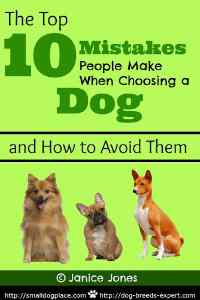
Free Monthly Newsletter
Sign Up for Our Free Newsletter and get our Free Gift to You.
my E-book, The Top 10 Mistakes People Make When Choosing a Dog (and how to avoid them)
